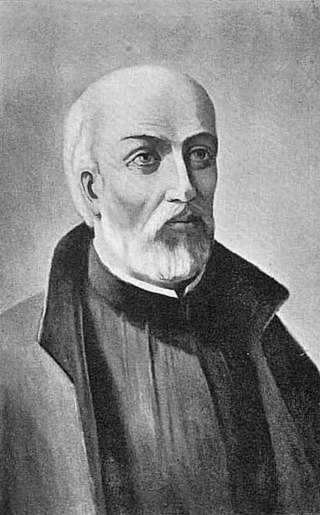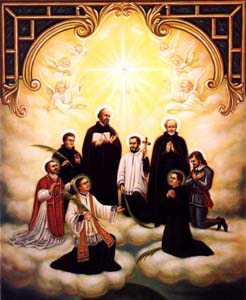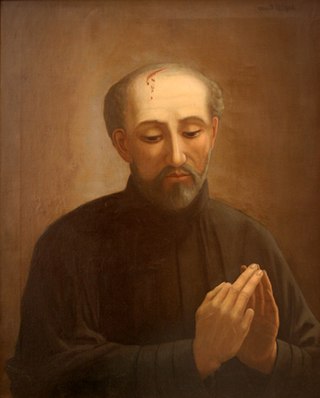
Jean de Brébeuf was a French Jesuit missionary who travelled to New France (Canada) in 1625. There he worked primarily with the Huron for the rest of his life, except for a few years in France from 1629 to 1633. He learned their language and customs, writing extensively about each to aid other missionaries.

The Canadian Martyrs, also known as the North American Martyrs, were eight Jesuit missionaries from Sainte-Marie among the Hurons. They were ritually tortured and killed on various dates in the mid-17th century in Canada, in what is now southern Ontario, and in upstate New York, during the warfare between the Iroquioan tribes the Mohawk and the Huron. They have subsequently been canonized and venerated as martyrs by the Catholic Church.

Charles Garnier, was a Jesuit missionary working in New France. He was killed by Iroquois in a Petun village on December 7, 1649.

Isaac Jogues was a French missionary and martyr who traveled and worked among the Iroquois, Huron, and other Native populations in North America. He was the first European to name Lake George, calling it Lac du Saint Sacrement. In 1646, Jogues was martyred by the Mohawk at their village of Ossernenon, near the Mohawk River.

Sainte-Marie among the Hurons was a French Jesuit settlement in Huronia or Wendake, the land of the Wendat, near modern Midland, Ontario, from 1639 to 1649. It was the first European settlement in what is now the province of Ontario. Eight missionaries from Sainte-Marie were martyred, and were canonized by the Catholic Church in 1930. Sainte-Marie Among the Hurons was designated a National Historic Site of Canada in 1920. A reconstruction of the mission now operates as a living museum.

Tay is a township in Central Ontario, Canada, located in Simcoe County in the southern Georgian Bay region. The township was named in 1822 after a pet dog of Lady Sarah Maitland (1792–1873), wife of Sir Peregrine Maitland, Lieutenant Governor of Upper Canada. Two other adjoining townships were also named for her pet dogs, Tiny and Flos.

René Goupil,, was a French Jesuit lay missionary who became a lay brother of the Society of Jesus shortly before his death. He was the first of the eight North American Martyrs of the Roman Catholic Church to receive the crown of martyrdom and the first canonized Catholic martyr in North America.

Noël Chabanel was a Jesuit missionary at Sainte-Marie among the Hurons, and one of the Canadian Martyrs.

Antoine Daniel was a French Jesuit missionary in North America, at Sainte-Marie among the Hurons, and one of the eight Canadian Martyrs.

Jean de Lalande, SJ was a Jesuit missionary at Sainte-Marie among the Hurons and one of the eight North American Martyrs. He was killed at the Mohawk village of Ossernenon after being captured by warriors.

Gabriel Lalemant was a French Jesuit missionary in New France beginning in 1646. Caught up in warfare between the Huron and nations of the Iroquois Confederacy, he was killed in St. Ignace by Mohawk warriors and is one of the eight Canadian Martyrs.
Jérôme Lalemant, S.J. was a French Jesuit priest who was a leader of the Jesuit mission in New France.

The National Shrine of the North American Martyrs, also known as the Shrine of Our Lady of Martyrs, is a Roman Catholic shrine in Auriesville, New York dedicated to the three Jesuit missionaries who were martyred at the Mohawk Indian village of Ossernenon in 1642 and 1646.

Jesuit missions in North America were attempted in the late 16th century, established early in the 17th century, faltered at the beginning of the 18th, disappeared during the suppression of the Society of Jesus around 1763, and returned around 1830 after the restoration of the Society. The missions were established as part of the colonial drive of France and Spain during the period, the "saving of souls" being an accompaniment of the constitution of Nouvelle-France and early colonial Mexico. The efforts of the Jesuits in North America were paralleled by their China missions on the other side of the world, and in South America. They left written documentation of their efforts, in the form of The Jesuit Relations.

Saint-Jean-de-Brébeuf is a municipality in the Municipalité régionale de comté des Appalaches in Quebec, Canada. It is part of the Chaudière-Appalaches region and the population is 397 as of 2009.
Jean de Brébeuf (1593–1649) was a Jesuit missionary who was martyred in Canada.
Joseph Chiwatenhwa is among the first believers of the indigenous peoples of Canada who accepted the Christian faith through the missionary and evangelistic work of the French Province of the Society of Jesus in the 17th century.

Camp Ondessonk is an outdoor, Catholic residential youth camp run by the Diocese of Belleville. It is located in the Shawnee National Forest of Southern Illinois, near Ozark, Illinois. The mission of the camp is "Exceptional outdoor and spiritual adventures empowering kids of all ages." Camp Ondessonk is accredited by the American Camp Association.
The Brébeuf Lake is a body of water tributary of the Saint-Jean River. It is in the municipality of Rivière-Éternité, Quebec, Canada.













